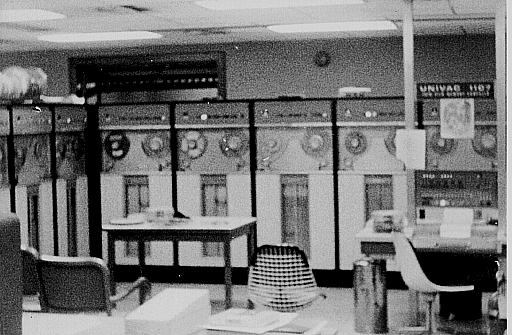

In the 1960s, the UNIVAC® 1107 provided the main computing facility for Case Institute of Technology in Cleveland Ohio in the United States. Operated by the Andrew R. Jennings Computing Center, the “Seven” enticed a generation into the world of computing and, with the innovative “fast turnaround batch,” “open shop” access pioneered at Case, provided a standard of service to a large community of users almost unheard of at the time. The Case 1107 was immortalised by being included by Case alumnus Donald Knuth in the calculation of the decimal representation of the MIX 1009 computer in The Art of Computer Programming.
In this view, we see the system console at the right, in front of the bank of UNISERVO™ II-A tape drives. The rounded cabinet at the very left of the frame is part of the TRW 530 “Logram computer”, which was used primarily to convert tapes between UNISERVO II-A 200 BPI format and the 800 BPI IBM-compatible format used by the UNISERVO VIII-C drives on the 1108 at Chi Corporation.
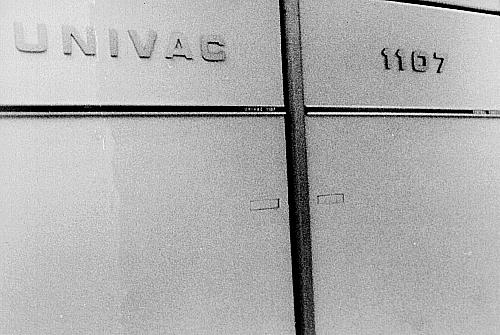
The UNIVAC 1107 was massive, but quiet. All of its main cabinets went from floor to ceiling, with air conditioned air injected through the raised floor and exit air exhausted through the dropped ceiling. Most of the central computer cabinets were walk-in. This one contained the main processor logic and the 65,536 36-bit words (about 256 K bytes) of core memory. Memory access time was 8 microseconds per word, but interleaving of instruction and data accesses allowed average access time to approach 4 microseconds in ideal conditions.
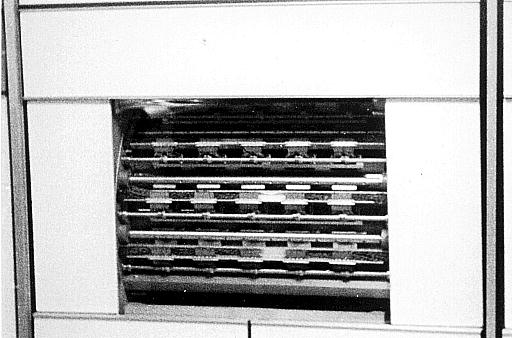
Mass storage for the single job run at a time, and for queueing waiting jobs and printer output for those already complete, was provided by the two FH-880 magnetic drums, which provided about 6 megabytes of random access storage.
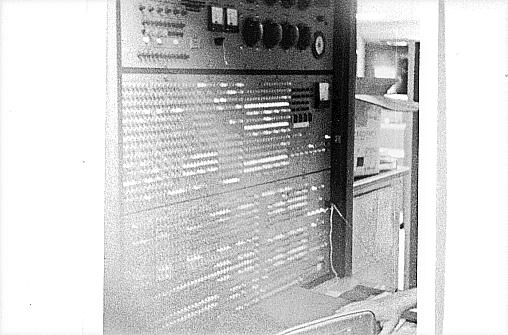
The central processor was a 36 bit architecture, capable of executing most simple arithmetic instructions in one 4 microsecond cycle time. Multiplication of two 36-bit integers took 12 microseconds, and division of a 72-bit dividend by a 36-bit divisor 31.3 microseconds. The processor performed 36-bit single precision floating point arithmetic in hardware, but did not implement double precision floating point.
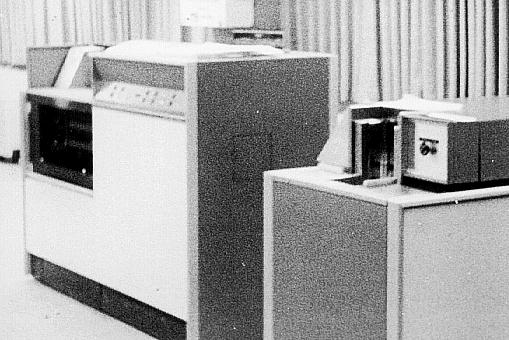
The high speed printer and card reader were connected directly to 1107 I/O channels. The printer was a rotating drum and hammer device which printed 600 lines per minute. The card reader read 600 cards per minute with two sets of brushes to read and verify the card; if both did not agree, reading would halt. Cards were grasped by a vacuum-equipped feed arm and fed into the mechanism. The “card eater” was notorious for jamming, sometimes demolishing student card decks which had been fed through numerous times in the process of debugging a program. Note the prominent Emergency Stop button to the right of the throat which ingested the card deck. Fortunately, students in the “open shop” environment in which the 1107 operated quickly learned how to field-strip the card reader and remove the remains of their programming projects when this happened.
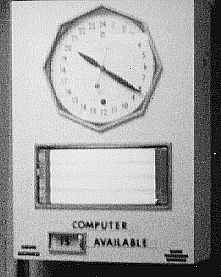 The high speed printer was derived directly from a printer used on the
UNIVAC I. Its hammers were driven by a bank of thyratron (gas-filled
power switching) tubes which were visible when the back of the printer
was removed. When the drum advanced so the desired character was
approaching the hammer, the tube would fire and whack the paper
against the drum from the hammer bank behind the page. The printer
incorporated a feature known as the “all out detector” which, if one
or more hammers failed to fire on a given line, leaving their
corresponding drive tubes not “out” (you could see the gas in
them glowing until they fired), halted the printer, permitting
the operator to examine the printer controller, note the missing
characters, open the printer carriage, write them into the
columns they belonged with a pencil or pen, then restart the
printer. The pace of life was so much slower then….
The high speed printer was derived directly from a printer used on the
UNIVAC I. Its hammers were driven by a bank of thyratron (gas-filled
power switching) tubes which were visible when the back of the printer
was removed. When the drum advanced so the desired character was
approaching the hammer, the tube would fire and whack the paper
against the drum from the hammer bank behind the page. The printer
incorporated a feature known as the “all out detector” which, if one
or more hammers failed to fire on a given line, leaving their
corresponding drive tubes not “out” (you could see the gas in
them glowing until they fired), halted the printer, permitting
the operator to examine the printer controller, note the missing
characters, open the printer carriage, write them into the
columns they belonged with a pencil or pen, then restart the
printer. The pace of life was so much slower then….
Also memorable about the high speed printer was that, due to its both
consuming and storing relatively large amounts of energy, along
with a supply of paper, its front panel was equipped with a Fire
indicator light and, directly below, an Extinguish button. I was a very
different person in those distant days of yore, and never pushed
Extinguish to see what, if anything, it did. However, one Friday night
while the system programmers and system programmer wannabes (myself
falling into the latter category) were watching Star Trek
in the hardware engineers' room (first airing of The
Original Series, you understand!) the Extinguish button lighted
up spontaneously without any obvious effect; a few switch flips turned
it off.

All jobs (“runs”) were initiated by reading in decks of punch cards from a card reader. This is the main keypunch room where most users prepared their programs. This room was open to anybody, 24 hours per day, and was equipped with IBM model 026 manual card punches. The individual at the keypunch is unidentified. Visible through the window at the end of the keypunch room is the computer room, with the UNIVAC 1004 card reader/punch and printer unit in the foreground. Here's a view of the 1004, with the keypunch room in the background.
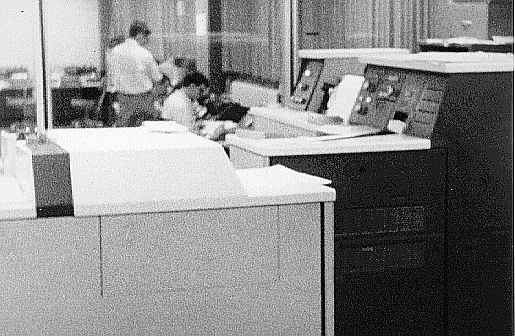
This machine read 300 cards per minute and printed 300 lines per minute. Though slower than the high speed reader and printer, it was more reliable and its output generally more legible, so many preferred it. Its card punch (at the left) was an awesome machine that punched an entire 80 column IBM card all at once. A huge electric motor powered the beast, and the GRRRrumble and then whump, whump, whump when it came to life brings back memories even today. The reader/printer unit is to the right. Punch cards were introduced into a hopper to the right of the printer and followed a tortuous path before emerging vertically in the bin visible at the right of the unit. This bin was slanted upward slightly and a weight with wheels on the bottom held the cards in place as the deck filled the exit bin. If you happened to feed a deck into the 1004 when this weight wasn't in place, the cards would spray out of the reader through the air every which way, completely scrambling the contents. This was extremely amusing to watch, as long as the cards weren't yours.
The 1004 jammed less frequently than the high speed reader, but when it did jam it could do so heroically. The high speed reader never destroyed more than a single card at a time, but the 1004 could jam in ways not detected by the machinery, which continued to feed more and more cards to their certain doom, until their torn remains sufficiently clogged the works to bring things to a halt. As I recall, the record for the number of crumpled and shredded cards removed from a single 1004 jam was 17, but I believe that was a 1004-II which ran twice as fast and was even more prone to jamming. Still, it was not unusual to lose four or five cards in a 1004 jam.
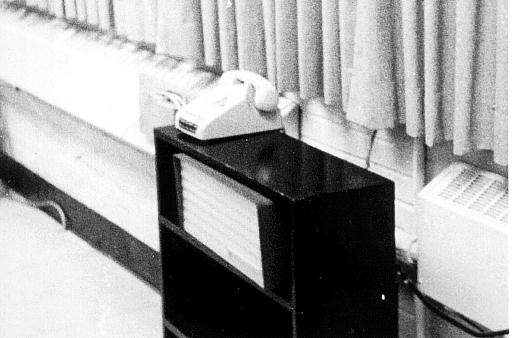
The Case 1107 was one of the first computers on Earth to provide access from remote locations both at other locations on the campus and as far afield as Erie, Pennsylvania. This is the 2400 baud leased line modem used for one of those connections. Now, if you have a modem, you need a port to hook it up to. Here's a pair of 2400 baud serial ports, 1960s style.
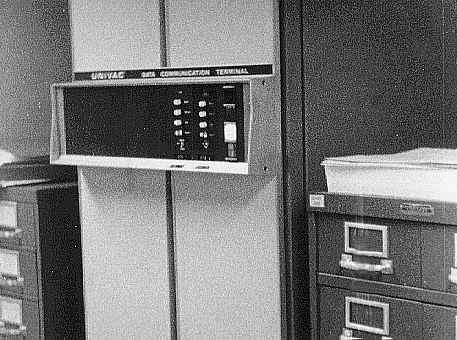
This floor-to-ceiling box (the file drawers for punch cards on either side provide a sense of scale) was called the CTS—short for “Communication Terminal, Synchronous”. It could contain either one or two synchronous serial ports, each on a dedicated I/O channel. This CTS has two ports; the vertical rows of round lights show input and output activity on each port. Not only did the CTS consume an entire I/O channel for each port (the 1107 only had 16 channels—you could put 16 tape drives on a channel or…one serial port), it was a prodigious memory hog. Input and output were stored with a single six bit character in each 36 bit word. If you transmitted and received small blocks of 1024 characters, and ran half-duplex so you didn't need separate input and output buffers, the data buffer for a single remote terminal would still consume 1/64th of the entire 65536 word memory of the 1107.

Day and night, the 1107 attracted individuals fired by the sense of wonder of what such a machine and its descendents, properly programmed, might do during their lifetimes. In this picture, from left to right, are John Richards, Ken Walter, John Langner, and Gene Hughes. John Walker snapped this candid picture. I don't recall the content of the cartoon that hung from the nameplate on the console rails…little help!

The 1107 was installed on the first floor of the Quail Building, shown above in a photo taken around 1966 by Bill Patterson. This is the same building which previously housed Case's UNIVAC I and Burroughs 220 computers. The keypunch room was on the near side of the left face of the building in this view, and the 1107 occupied the far half of the ground floor.
The photograph of the Quail Building is © 1966 Bill Patterson, used by permission. All other photographs in this document are by John Walker and have been placed in the public domain.
UNIVAC has been, over the years, a registered trademark of Eckert-Mauchly Computer Corporation, Remington Rand Corporation, Sperry Rand Corporation, Sperry Corporation, and Unisys Corporation. UNISERVO is a trademark of Sperry Rand Corporation, since merged into Unisys Corporation.